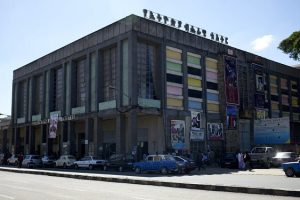BY MULUGETA GUDETA
Sculpture or the art of carving up statues is as ancient as human history and served good and bad causes or evil as well good purposes. Ancient Greeks and Romans erected statues not only for their living heroes but also for the gods they worshipped and the mythical creatures they held high in their fertile imaginations. The living gods of the Romans and the Greeks are still continuing their inanimate existence in art museums in the form of statues and monuments.
Their thoughts, philosophies and creativity have survived in books that still continue to fascinate and guide humanity. The ancients have contributed a great deal to human civilization by developing the art of sculpture but also to science and philosophy and this may be taken as the positive contribution of the art of sculpting to posterity.
The art of making sculptures was equally and even more widely used to carve up popular figures, the big and the mighty of their times as well as amazing churches and cathedrals, palaces and residences of the rich and powerful. Buddhist shrines and Moslem and Christian places of worship have contributed to human spiritual experiences and continue to do so. These places are not only objects of contemplation and meditation. In our modern times they have also become generators of huge incomes in the form of tourist attractions.
Ethiopians and Egyptians were celebrated in this kind of art in the time of Axum’s civilization and during the time of the Pharaohs in Egypt who built the might pyramids and tombs. The Ethiopian art of sculpture is an ancient art, particularly in the religious domain and among the imperial households that have built historical monuments to their faith and to their great leaders and monarchs. What the new generation holds in great respect and uses as tourists’ attractions are these very monuments that continue to fascinate even the modern architects and sculptors who are still trying to decipher their meanings and the sources of inspiration as well as the science of construction hidden behind them.
Patriotic and unifying leaders, like emperor Theodros, have always been appreciated for their contributions to the process of nation building even though their methods might be sometimes controversial. Emperor Theodros was famed for being a ruthless monarch who went to any length to implement his vision of Ethiopian unity. His fame has survived down to this very day and a monument is erected in his honor at a place in Addis Ababa. The monument is nothing other than a huge canon placed in the centre of the circular enclosure. The place is no doubt one of the tourist attractions in Addis Ababa.
Emperor Menelik was incontestably not only a great monarch who beat the Italian colonialists at the Battle of Adwa and inspired black pride that endures to these days. He was also great as a person, a compassionate man who refused to eat his feel when his subjects were suffering from famine and spent much of the famine years praying in the church, according to the late Professor Richard Pankhurst who wrote extensively about this period of Ethiopian history.
Menelik was such a modest and compassionate man who could easily identify himself with the commoners and his life history reads like a man of the world and not as a glorious monarch. Menelik too might have his share of mistakes as a human being but on balance his achievements far outweigh his mistakes. If great men were saints, there would be no need for them to be earthly rulers.
Emperor Haile Sellassie, was not shy when it comes to getting his pictures drawn in vivid colors and monuments erected in his memory although most of them have now disappeared following the revolutionary events that ended his rule almost 50 years ago. Whether he deserved such an adulation during his time in power might be questionable. However, there is no doubt that emperor Haile Sellassie was a modernizing monarch who did a great deal to the development of his country without forgetting that he was also fallible as a human being.
In the post-revolution period, of the last 50 years or so, monument carving and statue building was raised to a new level and assumed new motives and objectives. As the country slid into a period of revolutionary chaos and anarchy, the rulers of the times were fond of erecting statues to their “great achievements”. The monument known as “Tiglachin” (Our Struggle) that stands in front of the headquarters of Ethio Telecom in Addis Ababa, was erected in memory of the great works of the so-called revolutionary leaders but ended up in disgrace. The monument still stands although the worshippers have disappeared. The monument was built with North Korean money as a “gift” to the “great leaders” and the art was an imitation of the so-called socialist realism of the Korean brand under Kim Il Sung to whom the local leaders had great fascination as a model to imitate.
The cult of personality that was evident at that time was similar to Stalin’s cult in the former Soviet Union during the long period he served as Secretary General of the communist party. Stalin’s monuments appeared almost all over the country. Stalin standing on a high pedestal, stretching his hand in the air apparently showing the way to greatness.
His and Lenin’s monuments dotted the Soviet Union and were worshipped by the communist faithful until their idols fell and rolled down the steep precipice of history.
The art of erecting monuments to the greats of this world continued everywhere in the world. Unfortunately, those who craved for monuments were mostly the bad guys like former Iraqi president Saddam Hussein whose lifelike statue dominated one of the big squares in downtown Baghdad, was reduced to dust following the popular uprising against his rule.
Back in the early 1990s, when the now- defunct TPLF regime was barely settling in power, it launched a project to carve up its insane dreams into monuments and erected what it called the ‘monuments for the martyrs’, which in reality was a monument for its mad cravings of “eternal” power and privilege in the name of the people. Everything has an ending, bad or good. TPLF’s monument is now turned into a monument to self-aggrandizement, arrogance, and delusion of grandeur. Times change and the symbols monuments represent also change with history.
The TPLF would have done a better job had it used the millions it spent on the construction of the Mekelle monument, (and the billions it allegedly siphoned off during its time in power), to feed the starving people in Tigray. It could have thus gone down in history as a regime that was once a friend of the people although it degenerated into a cruel and greedy monster later on. Its present image is one of a pack of greedy dictators who desperately and stupidly hang on to power even when it was clear that their days were numbered. The same monument is still standing at its place albeit the fact that it now reflects the delusion of a party that goes down in history as another monumental failure.
Ethiopians are in general calm and farsighted people in the sense that their anger at this kind of delusion is often kept in check and does not boil over and lead to acts of political desecration that is common in other countries. They let good and bad monuments continue to stand side by side and reflect the good and the bad periods of their history. They leave the judgment of their leaders to eternity. This is also a reflection of the tolerance and respect common to Ethiopian culture that helps let bygones be bygones and allows the past be buried without much fanfare and with less sense of vengeance.
There is another monument to the victims of the Red Terror near Meskel Square on the way to Bole International Airport, which is visited both by families of the victims as well as by tourists who are interested in Ethiopia’s recent history. Yet, there had never been acts of vandalism or violence or acts of revenge on the part of the victims’ families. The Jews in Europe are still persecuted and their cemeteries are often desecrated by the anti-Semites of all hues, more than 70 years after the end of the Second World War.
Ethiopian culture is unique in the sense that that it is considered cruel to think or act ill of past leaders now that they are dead and buried. They don’t seek a second burial to these leaders through defamation and revenge. They rather choose honorary reburial to leaders who have been dishonored like emperor Haile Sellssie whose remains were taken out of the hole in the palace grounds and buried with full honors deserving of emperors.
Monuments may sometimes be tricky in the sense that they create illusions in the minds of the public even though all forms of art are illusions of reality. You can discard a piece of painting quite easily or hide it from public view but it is harder to discard a huge monument and delete it from popular memory. Whatever their outcomes, people continue to erect monuments to the good, the bad and the ugly and use them as markers of history and the art sculpting continues to be fascinating although the great men it sometimes depicts may themselves be victims of their own illusions and delusions .
The Ethiopian Herald 12 February 2021




